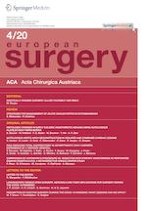03.04.2019 | original article
Histologic changes in early colonic anastomotic healing using autologous platelet-rich fibrin matrix
Erschienen in: European Surgery | Ausgabe 4/2020
Einloggen, um Zugang zu erhaltenSummary
Background
Anastomotic leakage represents a devastating post-surgical event with surgeon- and patient-related causes. The early lag phase of healing (day 0–4) is a time of increased vulnerability. The current role of tissue sealants as anastomotic adjuncts remains unclear, with controversial results reported. Platelet-rich plasma provides a reliable source of growth factors supporting wound healing. We aimed to assess the impact of a novel autologous platelet-rich fibrin (PRF) agent (Obsidian-ASG® matrix; GergMed Medizintechnik, Baiern, Germany) on colonic anastomotic healing in a porcine model.
Methods
Left-sided colonic anastomoses were constructed in 16 pigs with reinforcement using the Obsidian-ASG® matrix in 12 animals. Animals were sacrificed on days 0, 4, 10 and 30, with histologic assessment of the anastomotic line along with evaluation of fibrotic tissue maturation, foreign body reactivity and mucin production. Collagen maturity and immunohistochemical changes of angiogenesis and infiltrating macrophage profiles were determined as well.
Results
There was no observable effect in matrix-treated animals on epithelial line thickness, granulation tissue formation, foreign body reactivity or mucosal restitution. Matrix-treated animals showed higher mucin production on day 4 accompanied by a more mature collagen and a greater degree of early angiogenic response with a higher infiltration density of M2 macrophages. Additionally, anastomotic burst pressure in matrix-treated animals was higher on day 0, 4, 10 and 30 (100, 100, 210, 160 vs. 40, 30, 60, 20 mm Hg, respectively).
Conclusion
Obsidian-ASG® matrix may have beneficial effects on anastomotic healing by shifting the inflammatory response towards a mature and more stable collagen phenotype in the early phase.
Anzeige
